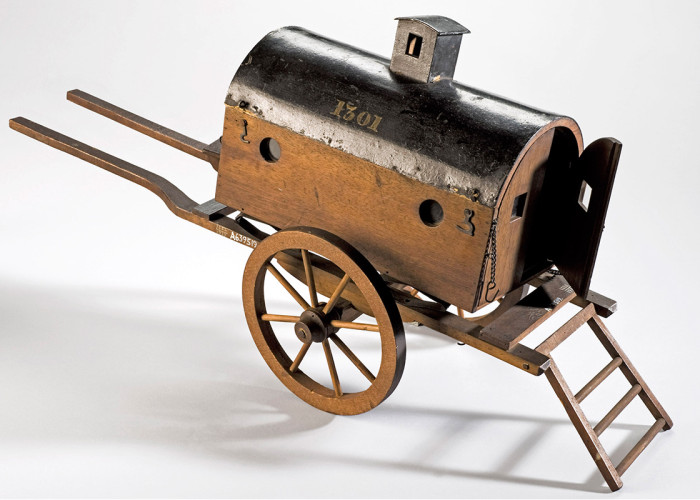Model of a French Battlefield Ambulance
This is a model of a two-wheeled sprung ambulance vehicle, as used by the French medical staff (Service de Santé) during the Revolutionary and Napoleonic Wars. This invention revolutionised battlefield medicine, letting wounded French soldiers get quick medical treatment, and was one of the first ambulances ever used.
Medical support is crucial to troops serving on the frontline. During and after the French Revolution (1789-1799) a French military surgeon named Jean Dominique Larrey, born in the Pyrenees, served in the French Republican Army on the Rhine. He, along with another surgeon Pierre François Percy, conceived an idea to provide close medical assistance. In Italy, whilst General Napoleon Bonaparte was campaigning against the Austrian and Northern Italian armies, the concept of a ‘Flying Ambulance’ came into being. The ‘ambulance’ was a support service and not just a vehicle, as illustrated here, in model form.
The Service de Santé served the Republic and then Napoleon Bonaparte’s forces from 1792-1815. As the French nation became involved in total war and engaged every citizen, it expected high standards from its doctors. Larrey and Percy saw the provision of close surgical support as an opportunity to boost morale and bring aid closer to their fighting comrades.
A full ambulance consisted of about 340 staff and equipment, which could be broken into smaller divisions (e.g. 110 men and 16 vehicles in each). A large ambulance could support an army corps, a smaller one, a division. There were twelve 2-wheeled vehicles (2 casualties in each) for light terrain and four 4-wheeled vehicles (4 casualties in each) for heavy terrain. The ambulance containers were sprung on metal and leather springs for increased patient comfort. The interior of the ambulance was padded and stretchers could be slid in and out of the rear doors of the cart.
-
Education overview
You can find out more about medicine on the battlefield on the Waterloo 200 Schools E-Book. Harris Academy, Battersea have researched the life of Lt. Anthony Bacon, a local soldier wounded at Waterloo.
If you’re a teacher, student, or parent, you can join the Waterloo 200 Schools programme. To find out how to sign up your class and discover your local Waterloo history, contact [email protected].
-
Curatorial info
- Originating Museum: Science Museum Group
- Accession Number: A639519
- Production Date: 1801-1850
- Material: Wood
-
Use this image
You can download a higher resolution image below, but please note the conditions of the licence.
- Rights Holder: Copyright Science Museum Group
- License Type: All Rights Reserved
Find it here
This object is in the collection of Science Museum








